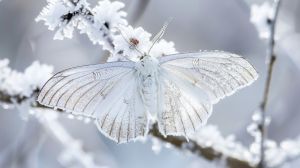Snow Moth: Difference between revisions
RaenAndaleio (talk | contribs) (Created page with "thumb| {| class="wikitable" |+ |- |'''Domain:''' |Eukariota |- |'''Kingdom:''' |Animalia |- |'''Phylum:''' |Chordata |- |'''Class:''' |Lepidothermia |- |'''Order:''' |Lepidornithes |- |'''Superfamily:''' |Umbreoptera |- |'''Family:''' |Umbriidae |- |'''Genus:''' |Vampyropis |- |'''Species:''' |V. stabbursdaleni |} The Snow Moth (''Vampyropis stabbursdaleni'', named after the Stabbursdalen National Park in Sweden, where it was first discovered), al...") |
RaenAndaleio (talk | contribs) No edit summary |
||
| Line 28: | Line 28: | ||
|- | |- | ||
|'''Species:''' | |'''Species:''' | ||
|V. stabbursdaleni | |''V. stabbursdaleni'' | ||
|} | |} | ||
]] | ]] | ||
Revision as of 02:14, 26 May 2024
The Snow Moth (Vampyropis stabbursdaleni, named after the Stabbursdalen National Park in Sweden, where it was first discovered), also known as Snow Vampire Moth or White Vampire Moth, is a magical creature resembling a moth, known for its icy white wings that provide perfect camouflage in snowy environments. Like all flutterlings, Snow Moths are warm-blooded. They maintain their body heat through insulating fur. These creatures are active exclusively in snowy conditions during the winter months, preying on hibernating insects.
Appearance
Snow Moths are characterized by their iridescent wings, which span around 15 cm and are typically white, with the occasional shade of ice blue. Fluff lining the edges of their wings give the appearance of frost growing on them. Their bodies are 4-5 cm long and covered in thick, insulating fur that helps them retain heat in freezing temperatures. The antennae of Snow Moths are feathered, aiding in their ability to sense minute changes in their environment, crucial for locating their prey.
Like all vampire moths, it possesses a long, stinging proboscis.
Habitat and Behavior
Snow Moths inhabit regions with consistent winter snowfall, including parts of Northern Europe, the British Isles, Siberia, and the higher altitudes of mountain ranges. They thrive in these cold environments where their camouflage is most effective. During the warmer months, Snow Moths enter a state of hibernation, encasing themselves in rock-like pupae that blend seamlessly with their surroundings, protecting them from predators and the elements.
Their behavior is largely dictated by their predatory nature and the availability of food. Snow Moths prey on hibernating insects, which they locate using specialized sensory abilities to detect the faint warmth and slight movements beneath the snow. They will then use their long stinging proboscis to reach their prey, inject digestive enzymes into it and drink the dissolved tissue. A Snow Moth's proboscis is remarkably strong, capable of penetrating through frozen ground and into tree bark. They are primarily nocturnal, using the cover of darkness to avoid predators while they hunt.
It should be noted that, unlike common beliefs, Snow Moths do not use their proboscis for defense. As such, they are completely harmless to humans.
Magic Abilities and Use in Magic
Snow Moths possess minor magical abilities that enhance their survival in harsh winter conditions. One of their primary abilities is the manipulation of ice and snow for improved camouflage. They can subtly alter the colouration and patterns of their wings to match their immediate surroundings, making them nearly invisible against a backdrop of snow and ice.
In magical practices, Snow Moths have little significance. While their magic is interesting, it is too weak to be useful for any serious application. There are stronger and more readily available sources for ice-based magic.
Conservation Status
Snow Moths are not a common sight, primarily due to their elusive nature and the specific conditions required for their survival. They are classified as "Near Threatened" due to the impact of climate change, which has led to warmer winters with less snow in parts of their traditional habitat, particularly in Europe. Despite this, Snow Moths continue to thrive in regions where heavy snowfall and cold temperatures persist.
Conservation efforts are focused on preserving their natural habitats by mitigating climate change and protecting winter ecosystems. Research into the environmental factors affecting their populations is ongoing, with a particular emphasis on understanding their breeding and hibernation behaviors to better support their conservation.

